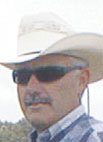
As Madison County residents gear up for the county fair this September, there will be a familiar sight on the sidelines of the showmanship ring: Jeff Williams instructing a child on how to handle an animal in order to win.
Williams mentored his daughters, Maggie, 21, and JoBeth, 18, when, as children, they began showing sheep and cattle at the Madison County Fair. He guided his daughters to the No. 1 spot in show steers at the county level for five successive years, beginning in 2002, and Maggie placed second in steer showmanship in the state in 2002. Honors, such as the 2000 Dustin Whittle Memorial and the 2005 “overall” beef showmanship awards at the Madison County Fair, line the entryway to the Williams’ Hindsville Valley home, and purple ribbons offset photo montages of the Williams sisters and their winning steers in their father’s in-home office.
With his daughters grown, Jeff Williams helps younger children get started in the fair by finding show animals, by loaning them supplies and by helping them fit animals for the show. He spends hours working with the children as they practice leading the animal and determining how to present it to the judges in the ring.
The Williamses understand the importance of community involvement, said Darrin Henderson, a Madison County extension agent and staff chair, who credits Jeff Williams’ behind-the-scenes work as a boon to the Madison County Fair. “He’s here every day, and he’s always willing to help out the younger kids, as far as giving advice and pointers on showing lambs and steers. If they have a question, he’s handy to have because he helps them out.”
What the Show Teaches Kids
What Williams likes about the county fair is that any child whose family has a yard affording space for at least a 12-by-12-foot pen can show an animal at the county fair. All children start out on equal footing, he noted, but it’s the self-discipline, the effort expended and the parental involvement that makes them a winner. “Once they get involved with that animal, you see their confidence inch up and you see how they begin to realize winning is within their reach,” said Williams, a former president of the Madison County Fair Board who once headed the fair’s sheep department.
Showmanship, Williams contends, is good for children, because it teaches them a skill set that easily translates into other areas of life, and it underscores how to maintain one’s composure and positive self-image when things go awry in public. When it comes to presenting the animal, the show itself, he maintains, is all about illusions.
“Put a 100-pound kid and a 600-pound calf together, and the kid quickly learns he’s got to use his brain to manipulate it,” Williams said. “It’s mentally tougher to learn to adapt to and to finesse that animal. They learn so much about presentation and appearance when showing an animal, and they learn that, through effort and dedication, good things happen for you,” he said.
Tam Williams, his wife of 27 years, added “When you work that hard, you want to win that purple ribbon. We’ve seen lots of tears shed.”
At the Farm
Darrin Henderson, the county Extension agent, said the Williamses know what it takes to make their Angus-based, genetically certified and naturally bred herd work. “They’re efficient, as far as what’s going in for income and what’s going out for expenses; they’ve got a good set of cattle with high calving rates (86.4 percent); and they’ve got their production system well-figured out with detailed records,” Henderson said.
Up until a couple of years ago, the Williamses owned purebred cattle, but economics and profit forced the switch to commercial cattle. The farm’s current operation has been off Arkansas 295 for more than 15 years, although Williams’ family has been farming in Madison County since about 1959. Genetics, nutrition and health combined help the herd prosper.
“The cows get hooked on fresh grass, and they tell us when it’s time to move,” Jeff said, walking among the black-hided, Angus-based 100 cow-calf pairs that gathered at a water trough near the family home. Elsewhere, there are 12 bulls (of which they own seven and lease five) and another 120 16- to 18-month-old heifers that will be sold as breed heifers this winter. “They eat more efficiently this way. They get 2 to 3 pounds of grain a day, plus all the fresh grass they can eat, and they can gain up to 1.5 pounds a day.”
By moving the livestock to forage during peak production periods, the Williamses have found that managing the pasture is an important crop in itself and the animals provide a way to market it.
While others spend their nonworking hours playing golf or fishing, Tam Williams said, “Jeff comes home, and we move cows.”







